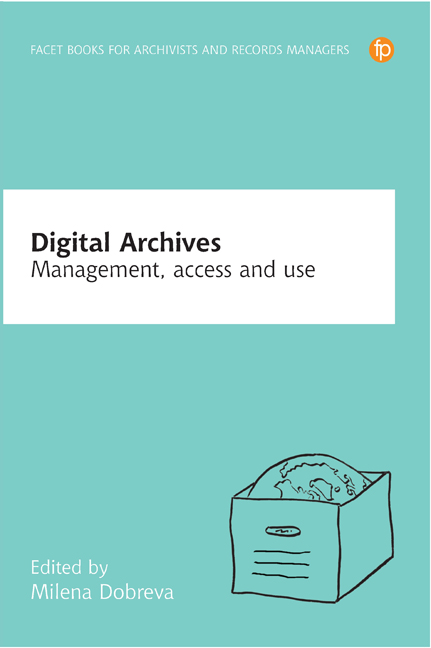Book contents
- Frontmatter
- Dedication
- Contents
- List of Figures and Tables
- Abbreviations
- Foreword
- Preface: Digital archives: management, use and access participatory approaches in archives
- Acknowledgements
- Notes on contributors
- PART I DRIVERS FOR MODERN DIGITAL ARCHIVES
- 1 Digital humanities and documentary mediations in the digital age
- 2 Managing turbulence
- 3 The political economy of digital cultural preservation
- 4 Legal issues surrounding digital archiving
- 5 Scientific information policies in the European context
- 6 Access to digital archives: studying users' expectations and behaviours
- PART II CASE STUDIES
- Afterword
- Index
2 - Managing turbulence
from PART I - DRIVERS FOR MODERN DIGITAL ARCHIVES
Published online by Cambridge University Press: 02 October 2019
- Frontmatter
- Dedication
- Contents
- List of Figures and Tables
- Abbreviations
- Foreword
- Preface: Digital archives: management, use and access participatory approaches in archives
- Acknowledgements
- Notes on contributors
- PART I DRIVERS FOR MODERN DIGITAL ARCHIVES
- 1 Digital humanities and documentary mediations in the digital age
- 2 Managing turbulence
- 3 The political economy of digital cultural preservation
- 4 Legal issues surrounding digital archiving
- 5 Scientific information policies in the European context
- 6 Access to digital archives: studying users' expectations and behaviours
- PART II CASE STUDIES
- Afterword
- Index
Summary
Introduction
Managing is getting things done through people. In the 1980s, the mantra was ‘management by walking around’, the idea that a manager who wandered through the workplace, observing people and equipment and working conditions, would encourage better performance and productivity. When a mechanical system – say, a digital one – is introduced between the manager and the people within the organisation, things change.
Managing in an archival organisation where some of the materials are digital is one aspect of the greater management realm. Using digital tools while managing people who work in the archives is another. How does the advent of the digital ecosystem in archives change the composition of the workforce that makes up the archival service? How does it change the management of staff? And how does it change the characteristics of managers?
First we will take a close look at hiring as an example of how thoroughly digital systems have captured a fundamental managerial responsibility. Then we will pull back to a wider view to see where staff members work and the electronic tools that are available to managers for supervision. Next we turn to the nature of the workforce itself and the changes that are possible by choosing digital management options. Finally, we will look at the characteristics of archival leaders in an organisation that depends on digital systems.
Hiring as an example of digital process
When a manager decides to hire, the first step is recruitment. Today that nearly always includes electronic distribution of the job vacancy announce ment. Although there is no single site for posting archives vacancies worldwide, governments have electronic sites where jobs are posted, some archival associations have electronic job sites, and archival listservs also post jobs (such as the listservs of the International Council on Archives and ARMA [Association of Records Managers and Administrators] International). The Society of American Archivists (SAA) boasts to employers that posting with the SAA online ensures that they will ‘find the best’, ‘meet their recruitment goals and attract top talent.’
Once the employers have the applications in hand (virtually), they can review not only the application but also the candidate's social media profile.
- Type
- Chapter
- Information
- Digital ArchivesManagement, use and access, pp. 23 - 38Publisher: FacetPrint publication year: 2018

